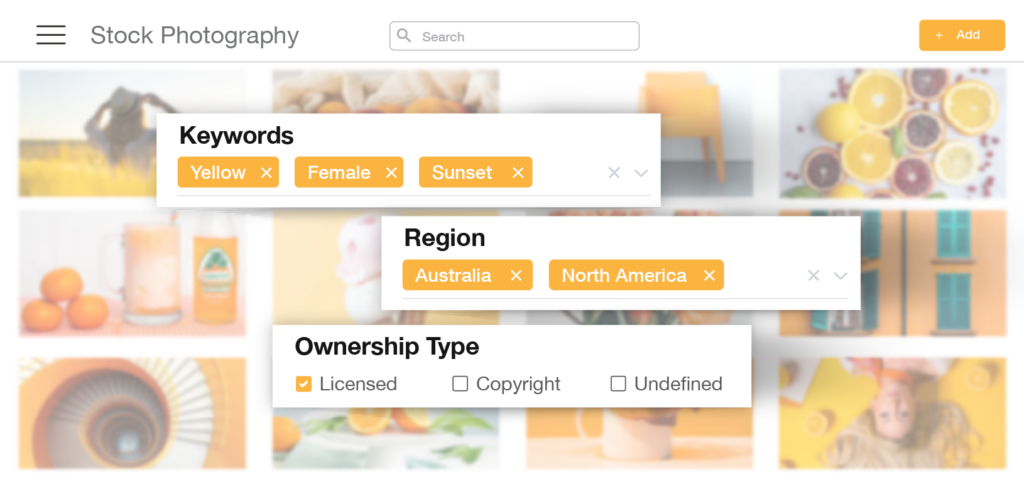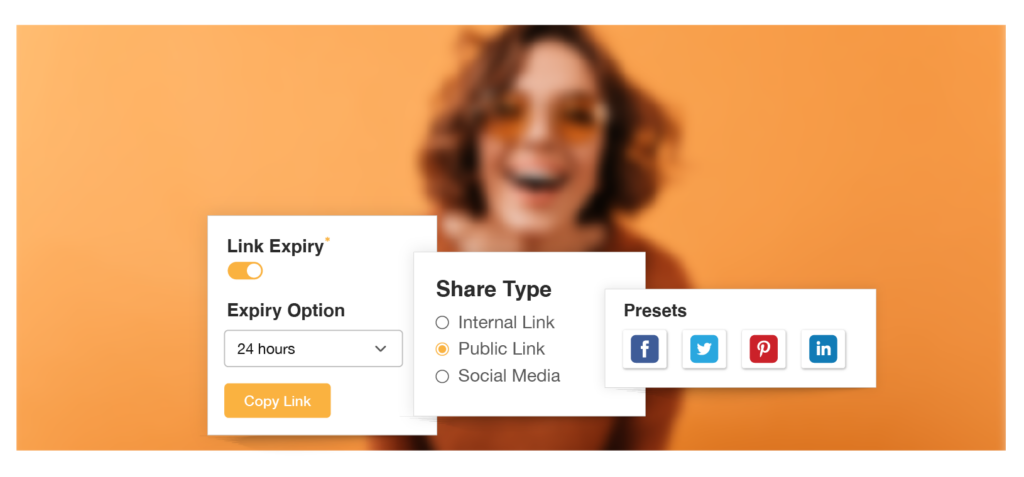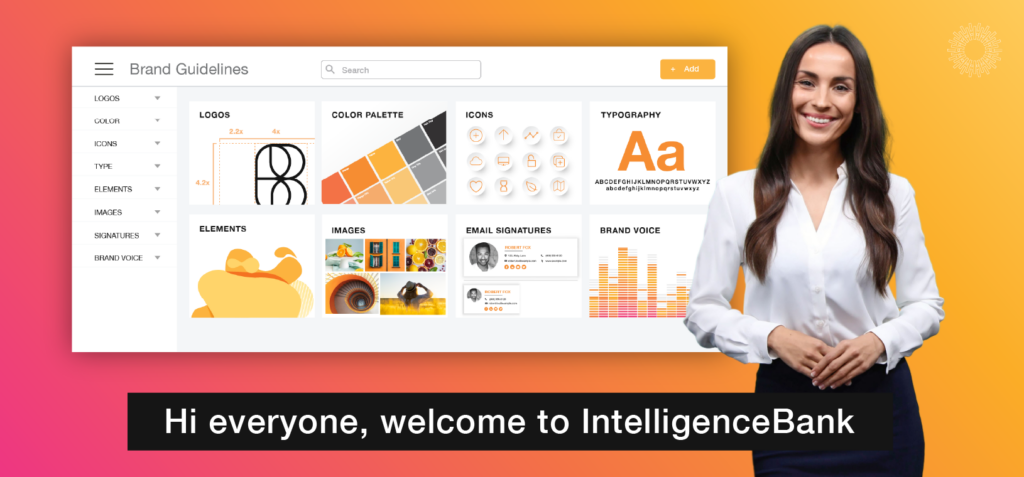Digital Asset Management (DAM) is the process of centralizing, organizing, storing, and distributing marketing content – especially digital creative assets – in an efficient manner. Digital assets include a wide range of file types such as images, videos, ads, logos, audio files, documents, presentations, and more.
DAM software systems provide businesses with a platform to manage these assets throughout their lifecycle, from creation to distribution and archiving. They make it easy for marketers to store, organize, search, retrieve, and share assets, ensuring seamless collaboration, brand consistency, and efficient workflows.
While there are other online file sharing systems out there, a DAM is the only software specifically designed to manage digital creative assets and their surrounding workflow. SharePoint for instance, is great for sharing documentation internally, and Dropbox is terrific at sharing synched files, but both lack the granularity of management offered by a DAM. A Digital Asset Management system is distinctly different to a Document Management System (DMS), which is designed for text based documents.
What are the benefits of a digital asset management system?
Digital Asset Management systems offer efficiency, organization, collaboration, and security benefits that can significantly improve the management of your creative files – whether they be photography or finished art, raw footage, final edits. A DAM is an essential tool for any business dealing with a large volume of digital content.
DAMs typically deliver exponentially increased productivity and efficiency, helping teams do more with less.
Implementing a robust Digital Asset Management system brings order to chaos that’s for sure, but beyond that, a DAM helps marketing teams overcome many other common challenges. Let’s explore the benefits of a digital asset management system:
Easily manage large volumes of complex assets
Marketers are generating more content every day – and that content is compounding. Managing this influx of assets manually or with traditional storage methods such as a hard drive, can quickly become overwhelming and inefficient.
A Digital Asset Management system simplifies the administration of these large banks of assets, ensuring they are easily accessible when needed. It does this via a centralized repository equipped with smart tools to help organize, categorize, and search for assets at lightning speed.
Time savings and improved productivity
Manual asset management processes are time-consuming and prone to errors. Without the assistance of a Digital Asset Management system, team members are lumbered with manually performing tasks such as manually inputting metadata, painstakingly tagging each file, cropping and resizing, and overseeing the time-consuming process of file conversions. This not only saps productivity but also hampers the creative and strategic aspects of marketing work.
In contrast, a DAM system streamlines these operations through automation, allowing marketing teams to allocate more time and energy to more rewarding efforts such as creative tasks, strategy development, and customer engagement.
Quick and easy asset retrieval
Today’s creative content cycle has little tolerance for delays. The demand for quick turnaround times and the constant need to produce fresh, engaging content places immense pressure on marketing and creative teams. The last thing you need to waste time on is fumbling around trying to find specific assets in large libraries. Creative content needs to leave the building blindingly fast, and at the same time be brand and legal approved.
A DAM system provides powerful search capabilities to approved content based on metadata, keywords, and visual recognition, enabling users to quickly pinpoint the asset they need from a vast repository in just a few clicks.
Enhanced version control and asset consistency
In collaborative work environments, the importance of maintaining version control and ensuring asset consistency cannot be overstated. Without a robust version control system, there’s the constant risk of different team members working on outdated versions, leading to confusion, miscommunication, and potential setbacks in projects.
A Digital Asset Management system acts as a safeguard against these issues by offering comprehensive versioning features. It provides features that track changes, enable rollbacks to previous versions, and ensures teams work with the most up-to-date assets, promoting consistency, eliminating confusion or worse, running the wrong material. DAM systems empower teams to collaborate with confidence, minimize the risk of costly mistakes, and maintain a cohesive and efficient workflow throughout the entire project lifecycle.
Consistent branding and asset usage
We all know establishing and maintaining a strong brand identity requires consistency over time across all marketing channels. But for global and franchise businesses, or businesses engaging in partnerships, it can be an administrative nightmare to police.
A Digital Asset Management system allows marketers to enforce brand guidelines, control access to approved assets, and track their usage, reducing the risk of inconsistent branding and ensuring brand integrity. This not only strengthens brand recognition but also engenders trust and ensures your brand’s reputation remains intact – regardless of the complexities involved in managing and disseminating marketing assets on a large scale.

Streamlined collaboration and workflows
Fragmented collaboration and siloed workflows hinder productivity. Without a unified system for managing digital assets, team members often resort to disparate tools and methods to share files, which can result in version control issues, missed communications, and overall inefficiencies.
A Digital Asset Management system provides a solution to these challenges. It serves as a hub where all team members review assets, provide feedback, and approval. Permissions are controlled meaning collaboration can happen amongst specific teams, departments, and external stakeholders. The centralized nature of the DAM acts to streamline workflows, enhance communication, and break down silos which promotes better communication.
Rights management and compliance
Proper rights management and compliance with licensing agreements, copyright, and usage rights are non-negotiable. Neglecting this aspect can lead to costly legal disputes and damage to a company’s reputation. With a Digital Asset Management system marketers have a powerful tool to not only store and manage these vital rights-related details but also to enforce and automate compliance.
A DAM’s secure repository has the ability to store comprehensive rights information associated with each digital asset, including licensing terms, usage restrictions, and expiration dates. This centralization ensures that all team members have access to the most up-to-date information, reducing the risk of unauthorized or non-compliant use of assets. As well as this, DAMs can automate expiration notifications which allows you to take a proactive approach to ensuring that assets are used within the bounds of their legal agreements. This not only mitigates the risk of legal consequences but also helps in building trust with content creators, licensors, and customers, as it signals a commitment to ethical and responsible asset management.
Enhanced security and asset protection
Protecting assets from unauthorized access, leaks, or breaches is paramount. A Digital Asset Management system goes above and beyond in ensuring the security of these assets.
By implementing robust security measures like access controls, encryption, and secure file transfers, a DAM system fortifies an organization’s defenses against potential threats. Access controls allow administrators to define who can view, edit, or download specific assets, ensuring that sensitive materials remain in the right hands. Secure file transfers further enhance this security by protecting data while it’s being shared or accessed externally.
In a time where data breaches and unauthorized access are major concerns, the comprehensive security offered by DAM systems not only safeguards the integrity of your digital assets, but also helps maintain trust and compliance with data protection regulations.
Data-driven decision making and ROI measurement
Everyone loves a metric. Why? Because understanding asset performance and return on investment is essential for optimizing marketing efforts. A DAM system provides analytics capabilities to track asset usage, engagement, and performance, empowering businesses with data-driven insights for informed decision-making as well as demonstrating the value of assets.
These analytics provide valuable insights into various aspects of asset management, such as understanding which assets are the most popular, the channels through which they are accessed, and the audience engagement they generate.
When marketers can track asset usage, engagement, and performance, businesses gain a deeper understanding of what resonates with their target audience. This not only helps in optimizing current marketing efforts but also guides future content creation. By analyzing metrics, you can make data-driven decisions about which assets to prioritize, adapt, or retire, thus maximizing the return on investment.
These data-driven insights provide a quantifiable means to demonstrate the value of digital assets to stakeholders, making it easier to justify investments in content creation and management systems like the ROI on a DAM itself.
What assets can be stored on a DAM?
DAMs are designed to accommodate a wide range of digital assets across various formats. But best of all, a Digital Asset Management system offers file flexibility. Need a PNG but the source file is a TIFF? A DAM can convert the file in one click.
Here are some examples of the types of assets that can be stored on a DAM:
Images and photographs
DAM systems are invaluable for storing a wide array of visual assets, encompassing images and photographs in various formats, such as JPEG, PNG, TIFF, or RAW files. This versatile support for file formats ensures that the system can accommodate your most diverse content needs.
In practice, this means that product images can be neatly organized and accessed when updating e-commerce websites or catalogs, marketing departments can efficiently manage their promotional materials and campaigns, while brand logos and design elements can be maintained consistently and protected within the DAM’s secure environment.
Importantly, DAM software can integrate with stock photo libraries so images can be easily retrieved from within the system. This saves an untold amount of time switching and downloading assets between platforms.
Videos and animations
DAMs excel at supporting a wide range of common video formats such as MP4, MOV, and AVI. This versatility is crucial, as different projects and media may require various video formats for compatibility and quality. It’s important to note that DAMs go beyond a mere storage ‘bucket’. They provide a range of features that enhance video asset management. For instance, they have the ability to preview videos to ensure they meet specific requirements, transcoding options to adapt videos for various platforms and devices, as well as the ability to generate closed captions.
These functionalities make DAMs indispensable tools for organizations seeking to optimize their video content workflows, ensuring accessibility, compliance, and seamless distribution.
[H3] Podcasts and Audio files
Digital Asset Management systems are capable of storing and managing a diverse range of audio files. The types of files commonly stored include music tracks, podcasts, sound effects and voice recordings. These audio files are often stored in a range of formats including MP3, WAV, or AIFFs.
While this capability is useful for all marketers, it’s invaluable for media companies, podcast producers and advertising agencies that rely on audio content to conduct their day-to-day business.
Documents and presentations
DAM systems are not limited to media files; they can also store various document types, including PDFs, Word documents, Excel spreadsheets, PowerPoint presentations, and more. This allows businesses to manage and share important documents alongside their media assets.
Storing documents in a DAM system brings several advantages. It ensures that the latest versions of documents are readily accessible to authorized users, promoting version control and collaboration. This centralized approach simplifies the process of sharing important materials within the organization or with external stakeholders, which enhances efficiency and document management practices.
A DAM can also categorize, search and apply metadata to these documents ensuring users can quickly locate the specific information they need, contributing to a more streamlined and organized document management process.
Design files
Design files, such as Adobe Photoshop (PSD) or Illustrator (AI) files, can all be stored on a DAM system. This is particularly useful for creative teams as it enables them to maintain version control and collaborate effectively.
As well as storing design files, DAMs can also integrate directly with third party design software, (such as Adobe). So as well as centralizing design files in a DAM, creatives can also have the tools needed for productive design workflows that help them keep track of various iterations. As creative files often represent the core of a communication project, maintaining version control is paramount to ensure that the latest and most accurate designs are used. With a DAM system, teams can confidently track the evolution of design assets, view the revision history, and access the precise version they need.
Marketing collateral
Digital Asset Management systems are perfect for managing finished art for marketing collateral like brochures, flyers, banners, and ads. These assets can be organized, tagged, and distributed to the appropriate teams or external stakeholders easily.
These materials are often subject to frequent updates and adaptations, making their efficient management super important. A Digital Asset Management (DAM) system really comes into its own here as it includes so many tools to help manage and track completed assets.
Social media assets
Social media has well and truly established itself as a legitimate channel for engaging with audiences, building brand presence and sharing content. Due to the relatively low production cost and ease of execution, sometimes the volume of social assets can outnumber other types of traditional media assets. This is why they need to be managed in a way that makes them easy to find and categorize – for example profile pictures, cover images, infographics and video.
DAMs also allow users to download assets for use on social media to pre-set specifications, (as required by companies such as Meta or LinkedIn). This makes it infinitely easier to turn something like a blog image into a LinkedIn banner.
By centralizing these social media assets within a DAM system, you can ensure brand consistency across different platforms, easily access the right assets for various campaigns, and efficiently adapt and repurpose content for different channels.
Other file types
In addition to all the asset types already mentioned, Digital Asset Management systems can store a wide range of other file formats, including text files, fonts, vector graphics, HTML files, and more. This versatility is a testament to the adaptability of DAM systems, making them well-suited to a multitude of industry-specific asset requirements. Whether you’re in publishing, design, e-commerce, or any field that relies on an assortment of digital resources, a DAM system’s capacity to handle various file types ensures that all your assets can be efficiently managed, organized, and accessed from a single, unified platform.

Businesses that benefit from using DAM
Digital Asset Management systems offer significant benefits to medium and large businesses across various industries. These include fast moving consumer goods organizations, e-commerce, manufacturers, advertising and media agencies. DAMs are also increasingly being deployed by businesses operating under strict compliance regulations, like healthcare and finance. They rely on DAM to ensure that branding and regulatory standards are met consistently, reducing the risk of costly legal issues.
Essentially, any company frequently dealing with large volumes of digital content, collaborates extensively, or requires strict compliance with branding and regulatory standards are particularly well-suited for a DAM system.
Key features of DAM systems
Digital Asset Management systems offer a robust set of features and functionality to manage digital assets effectively. Let’s explore some of the key features that make DAM systems indispensable for businesses:
Asset organization and metadata management
Asset organization and metadata management are fundamental aspects of a Digital Asset Management system. DAMs allow businesses to create a logical folder structure and apply metadata, enabling efficient asset organization and easy retrieval.
Metadata plays a key role in a DAM system.
It is what truly elevates a DAM from all other file management systems. Metadata includes information such as title, description, keywords, copyright, technical information about the asset and usage rights. For instance, metadata can indicate when an image was created, who the copyright holder is, the asset’s purpose, and even its usage restrictions. This detailed metadata not only assists in finding assets swiftly but also serves critical roles in rights management, compliance, and creative asset tracking. It transforms assets from anonymous files into valuable resources that can be efficiently located, understood, and utilized throughout an organization’s creative processes and content distribution.
Version control and asset versioning
Maintaining version control across multiple team members collaborating on assets can be a challenge without a DAM. DAM system offers a structured approach to versioning, ensuring that users can easily access and, if necessary, revert to previous iterations of an asset. This not only reduces the risk of working with outdated or incorrect versions but also fosters collaboration and creativity by enabling teams to experiment with assets without the fear of losing prior work.
For businesses operating under strict regulatory codes, version tracking is a valuable feature for compliance and audit purposes. A DAM can maintain a complete record of changes and approvals for each digital asset, which is crucial for maintaining transparency and accountability.

Rights management and permissions
Managing rights and permissions is essential to ensure compliance and prevent unauthorized use of assets. They help address issues such as compliance, security, and intellectual property protection. With the exponential growth of digital content, ensuring that assets are used within the bounds of legal and licensing requirements is of utmost importance. A DAM system offers a comprehensive solution for managing rights and permissions.
DAMs provide granular control over user access, permissions, expiration dates, and usage rights. They ensure that your organization operates within legal frameworks, reducing risk.
Search and retrieval capabilities
Powerful search functionality is a hallmark of DAM systems. Users can quickly locate assets based on a variety of search criteria, including metadata, keywords, custom fields, and even cutting-edge visual recognition technology.
This means that users don’t need to spend valuable time sifting through a labyrinth of folders or directories to find the asset they need. Instead, they can simply enter relevant search terms or apply filters to pinpoint the exact content they’re looking for.
As a result, DAM systems not only streamline the asset management process but also contribute to increased productivity and the efficient utilization of valuable resources. This allows your marketing team to respond to opportunities quickly and effectively.

AI for enhanced tagging
AI and machine learning have revolutionized DAM systems, enabling automatic metadata tagging, auto-classification, and smart asset recommendations. These capabilities enhance search accuracy, asset discoverability, and overall workflow efficiency.
AI algorithms can automatically analyze the content of assets, whether they are images, videos, or documents, and generate relevant metadata, keywords, and tags. This not only saves time and effort but also significantly improves the precision and consistency of asset categorization.

Asset sharing and collaboration
Whether it’s a marketing team working on a new campaign, a creative agency collaborating with a client on design assets, or a global organization managing content across multiple regions, DAM systems provide a common centralized platform to share assets with internal teams, external stakeholders, or clients.
In addition to secure file sharing, DAM systems come with features that enhance collaboration further. Comment threads allow team members to discuss specific assets, share feedback, and brainstorm ideas directly within the platform.
Annotations enable users to highlight areas of interest or make notes on images and documents, simplifying communication and feedback processes.

Asset approval
Approval workflows automate the often complex process of reviewing and approving assets, ensuring that everyone is on the same page and that assets meet the necessary standards before being used.This collaborative capability is not just about convenience; it can significantly improve productivity and accuracy by reducing the need for lengthy email threads or in-person meeti

Closed captions for video and audio
DAMs can generate closed captions for videos and audio directly within the platform. This ensures accessibility compliance, improves the user experience, and expands the reach of video assets without the need for third-party tools.
The inclusion of closed captions significantly enhances the overall user experience. Viewers can easily follow the content, even in noisy environments or situations where audio playback is not possible. This accessibility not only benefits individuals with hearing impairments but also a broader audience, making video and audio content more inclusive and engaging for everyone.

Headless DAM
Headless DAMs represent a departure from traditional DAM systems by decoupling from the standard provider interface, yet allowing all the same functionalities to seamlessly integrate with a diverse range of platforms, technologies, and applications. This approach offers businesses a new level of flexibility and adaptability in how they distribute and utilize their digital assets.
By adopting a headless DAM solution, you can ensure your digital content is not limited to a single ecosystem or application but can be effectively utilized across numerous touchpoints. This adaptability is especially crucial when content needs to be distributed to websites, mobile apps, social media, e-commerce platforms, and other digital channels. With headless DAM, businesses can easily provide content to any channel or technology that requires it, ensuring a consistent and up-to-date brand presence.
Who benefits from using a DAM?
Digital Asset Management systems don’t just help marketers. They can help a wide range of roles within an organization as well as its business partners.
Marketing campaign managers
Marketing campaign managers clearly benefit from DAM systems as they gain streamlined access to campaign assets, can facilitate team collaboration, and efficiently track campaign performance. With a DAM system, they can ensure smooth campaign execution that ultimately delivers successful marketing initiatives.
Brand managers
Brand Managers use Digital Asset Management systems to maintain brand consistency and manage brand assets. A DAM system provides a central source of truth for brand assets, ensuring easy access to approved logos, images, and other brand elements. It helps enforce brand guidelines in order to maintain consistency as well as brand and legal compliance across all channels.
Marketing leaders
People such as CMOs and Marketing Directors, benefit from DAM systems’ strategic insights into marketing assets and campaigns. DAM systems offer visibility into asset performance, analytics, and ROI, enabling data-driven decision-making. Marketing leaders can leverage DAM systems to align marketing strategies with business goals, ensure brand integrity, and maintain legal compliance.
Franchisees and franchisors
Digital Asset Management systems offer substantial benefits to both franchisors and franchisees within a franchise network. Franchisors, as the parent company, have a vested interest in maintaining brand integrity and ensuring a consistent customer experience across all locations. For them, a DAM system serves as a strategic tool to achieve these objectives. It enables franchisors to centralize their marketing assets, making it easier to maintain brand consistency and making compliance hard to get wrong
Franchisees benefit from accessing localized marketing materials and operational documents knowing they are approved for use. This ready access to materials tailored to their specific needs can significantly boost the efficiency of local marketing efforts and day-to-day operations.
Non-marketing users
DAM systems also provide value to non-marketing users across departments. Sales teams access up-to-date sales collateral, customer support teams access support materials, legal and compliance teams manage critical documents efficiently, and HR teams centralize employee-related assets. DAM systems also empower non-marketing users by streamlining workflows and enhancing collaboration.
How to choose the right DAM?
A DAM is an investment in efficiency and compliance, so knowing how to buy a digital asset management system is crucial. To make the squeeze worth the juice, you need to make sure you choose a service that will deliver maximum benefits and at the same time, offers a smooth implementation. Consider these factors when choosing a DAM solution:
Assessing your organization’s needs and goals
This involves a comprehensive evaluation of your unique requirements, which can encompass a wide range of factors. For example, what type of asset will you store, who will use the system, your collaboration needs, integration with existing systems, scalability, and budget. Conducting a thorough needs assessment helps align your goals with the capabilities of the DAM system. It is a fundamental step towards building a business case.
Evaluating DAM solution providers
Research and evaluate DAM solution providers based on factors like reputation, independent verified customer reviews, industry experience, security measures, support and training offerings, and pricing models.
There are many factors that influence how much a digital asset management system costs. Request demos and trials to assess the user interface, usability, and compatibility with your existing infrastructure.
Integration with existing systems and workflows
Evaluate how the DAM system integrates with your existing software stack, such as content management systems (CMS), project management tools, marketing automation platforms, or creative software. Seamless integration improves efficiency ensuring your DAM is used.
Scalability and future-proofing
Consider your organization’s growth plans and whether the DAM system can accommodate increasing asset volumes, users, and functionalities. A scalable solution ensures long-term viability and prevents the need for frequent system replacements.
How to implement a DAM system
Deploying a DAM system requires careful planning, coordination, and user adoption strategies. Follow these steps for a successful DAM implementation, keeping in mind your organization’s unique needs and objectives.
Planning and preparation
Define implementation goals, create an implementation team, establish a timeline, and set clear expectations. Develop a roadmap that covers data migration, system configuration, metadata schema, user training, and change management. During the planning and preparation phase of implementing a DAM system, it’s crucial to involve key stakeholders and end-users to ensure their input is considered in goal-setting and expectations. This collaborative approach fosters a sense of ‘buy-in’ and leads to a smoother implementation process and increased user adoption.
Data migration and asset ingestion
Ensure a smooth transition by properly migrating existing assets to the DAM system. Develop a migration plan, clean and organize assets, validate metadata, and define naming conventions to maintain consistency.
It’s crucial to engage a dedicated team or expert responsible for overseeing the data migration process to ensure a seamless transition. This team should work closely with DAM system administrators to minimize disruptions and maintain data integrity during the migration.
Configuring metadata and taxonomy
Design a metadata taxonomy that aligns with your organization’s needs and asset management goals. Consistent and well-structured metadata enables effective asset search, retrieval, and organization.
It’s important to configure metadata and taxonomy according to the unique requirements of your organization. A thoughtfully designed metadata taxonomy ensures that assets are not only organized effectively but also that they can be easily located and utilized across different departments and projects, promoting enhanced collaboration and efficiency.
User training and change management
Invest in comprehensive user training to ensure successful adoption and utilization of the DAM system. Communicate the benefits of DAM to users, provide hands-on training, and establish ongoing support channels to address user queries and concerns.
As well as user training, effective change management is essential for a smooth DAM system implementation. Create a change management strategy that involves clear communication, identifies key stakeholders, and addresses any potential resistance to change within the organization. This approach will help build a positive environment for adopting the DAM system and ensure that its benefits are maximized.
Monitoring and continuous improvement
Regularly evaluate and monitor the performance of the DAM system against predefined goals and metrics. Gather user feedback, identify areas of improvement, and implement necessary adjustments to enhance the DAM system’s effectiveness.
It’s essential to foster a culture of continuous learning and adaptation within your organization. Encourage a feedback loop that actively engages users and stakeholders, enabling the DAM system to evolve and align with changing needs and technological advancements, ultimately ensuring its long-term value and relevance.
Best practices for managing digital assets
To optimize the use of your DAM system and streamline asset management, follow these DAM best practices:
Create a simple folder structure
Keep your hierarchy simple, with no more than three levels of folders. Establish a consistent naming convention for folders and subfolders, making it easier to navigate and locate assets.
It’s advisable to regularly review and refine your organization’s DAM practices to adapt to changing needs and ensure ongoing efficiency. This flexibility allows your system to remain user-friendly and adaptable as your digital asset library grows.
Implement consistent naming conventions
Apply standardized naming conventions to assets to ensure uniformity and ease of search. Consistent naming practices facilitate asset identification and reduce confusion among users.
By adhering to standardized naming conventions, you not only ensure uniformity and ease of search but also create a more efficient and user-friendly digital asset management system, ultimately streamlining workflows and reducing the risk of errors in asset identification and retrieval.
Apply metadata and tags effectively
Leverage metadata to provide rich context to assets. Use descriptive keywords, descriptions, copyright information, usage rights, and other relevant data. Implement a consistent tagging system to improve asset discoverability.
Implementing a consistent tagging system not only improves asset discoverability but also facilitates efficient organization and retrieval of assets, ultimately enhancing productivity and ensuring that your DAM system is utilized to its fullest potential.
Develop rights management strategies
Establish clear policies and guidelines for managing rights and permissions. Document usage rights, expiration dates, licensing information, and user roles to ensure legal compliance and prevent unauthorized usage.
Once set, it’s important to regularly audit and update this information as part of DAM best practices. This ongoing maintenance ensures that usage rights remain accurate, licenses are up to date, and that any changes in user roles are promptly reflected, further reinforcing legal compliance and preventing unauthorized usage.
Set review dates for assets
Regular assessments help identify outdated or irrelevant assets, removing duplicates and making necessary updates. Automated notifications streamline the review process and keep your digital asset library up to date.
Incorporating set review dates for assets is critical to maintaining the relevance and efficiency of your digital asset library. Automated notifications and regular assessments not only streamline the review process but also ensure that your organization’s content remains current, accurate, and aligned with evolving needs and standards.
Regularly review and update metadata
Regularly reviewing and updating asset metadata is a fundamental DAM best practice that ensures the system remains effective. By removing outdated or redundant metadata and enhancing asset descriptions as needed, organizations can not only maintain organization and accuracy but also adapt to evolving business needs, staying in step with the dynamic nature of digital content management.
So now you know
Well done, you’ve graduated Digital Asset Management 101. DAMs have become indispensable for businesses managing their growing volume of digital assets efficiently. By implementing a DAM, businesses can overcome challenges related to asset organization, collaboration, brand consistency, compliance, and security.
Remember, implementing a DAM requires careful planning, user training, and ongoing maintenance. Choose the right DAM solution that aligns with your goals and growth plans. With a well-implemented DAM system in place, your organization can unlock the true potential of your digital assets.
Interested?
Read more to find out if a DAM is right for your business.





